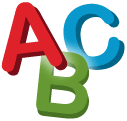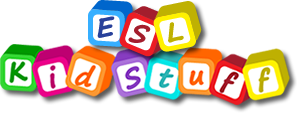Tips for Teaching the Alphabet to Young Learners of English
 Teaching the alphabet to our English students can be a daunting task. How can we teach all 26 letters (to recognise, read and write) along with their corresponding sounds in a fun and interesting way? How can we make sure our students internalize these letters? How can we help our students take their first steps towards reading?
Teaching the alphabet to our English students can be a daunting task. How can we teach all 26 letters (to recognise, read and write) along with their corresponding sounds in a fun and interesting way? How can we make sure our students internalize these letters? How can we help our students take their first steps towards reading?
Here are our top 10 tips on teaching the alphabet in your kids English lessons:
1. Different Learner Types
When teaching the alphabet for the first time it is important to remember that everyone learns in different ways, so we want to cover all of these learner types (see our article on “6 different types of ESL learners”). Simply showing a flashcard of a letter and getting students to say the letter will not be enough to help a child who is, for example, a Tactile learner (learns by touching and manipulating objects). Here are some methods you can include in your alphabet teaching routine to ensure all of your students get the most out of your alphabet lessons:
- visual: show alphabet flashcards with a letter on the front and a picture on the back (e.g. a / apple). Have alphabet posters on the walls and alphabet picture books.
- listening: say the sounds of each letter clearly and repeat a few times so your students can clearly hear the sounds. Play the ABC song.
- touch and manipulation: use alphabet blocks which students can touch and pass around. They can also use the blocks to put the letters in the right order. Let students trace the shape of the letters on the flashcards and then “draw” the shapes with their fingers on the floor and doors, etc. Use play-doh to make the letters. Play the ABC song and have the students touch the letters as they are sung.
- movement: have students make the shapes of the letters with their hands and bodies. For example, for the letter “c”, students can cup their hands or bend their bodies into a “c” shape. For more difficult letters, students can make the shapes in pairs or 3s (e.g.two students can make the body shapes for “b”, “d”, “m” etc. by working together).
2. Teach sounds
As you teach each letter of the alphabet always teach its associated sound. With each letter that you teach, teach 3 sounds:
- the pronunciation of the letter (E.g. “A”)
- the sound of the letter (“ah”)
- a word which begins with the sound (“apple”)
Therefore, a teacher may teach as follows for the letter “A”:
T: (showing a flashcard of the letter A) “A .. A .. A .. repeat A”
Ss: “A”
T: “A”
Ss: “A”
T: “A”
Ss: “A”
T: “A is for ah .. ah .. ah. Repeat ah”
Ss: “ah”
T: “ah”
Ss: “ah”
T: “ah”
Ss: “ah”
T: “A, is for ah, is for (turning the card over) apple .. apple .. apple .. repeat apple”
Ss: “apple”
T: “apple”
Ss: “apple”
T: “apple”
Ss: “apple”
T: “Good! What’s this?” (showing “A”)
Ss: “A”
T: “Is for?”
Ss: “ah”
T: “Is for?” (turning the card)
Ss: “apple”
T: “Well done!” (now asks individual students)
3. Use worksheet printing exercises
There are lots of alphabet worksheets in our worksheet alphabet section.
- Use letter tracing worksheets so students can practice tracing the correct shapes. As students trace each letter encourage them to say the letter as they trace (e.g. “A, B, C, …”). Also, ask your students questions as they are tracing (e.g. what’s this letter? What sound is it?”).
- Use worksheets to copy letters (not just trace). Again, ask questions as the students are writing the letters. Check the letters are correct in terms of shape and size and that they are written on the line.
- Have matching exercises where students match letters to the same letters (e.g. match A to A and B to B) and letters to pictures (e.g. match a to apple).
- For younger kids, always have a coloring in task (e.g. coloring an apple for letter A or coloring in block letters).
- Have a variety of different worksheet exercises to keep the interest of the students.
- Always have worksheets to do in class and for homework.
4. Make use of posters and real materials
For example, if you are teaching the letter “C” have your students find and touch the letter “C” on posters. Bring in magazines and have your students find and touch (or cut out) letter Cs. When you are reading a story to the class, you can sometimes ask your students to identify a letter they have learned.
5. Sing the ABC Song (The Alphabet song) regularly
Kids pick this song up really quickly and it will help them in remembering the order of the alphabet.
6. Play lots of alphabet games
We have over 30 great games on our Alphabet games page. Each week play a game the class has played previously and also teach a new game. Before you know it, your class will have learned lots of great alphabet games to play.
7. Start teaching common letter clusters early on
Kids are surprisingly good at picking up on clusters and this will help your students when they start to read. For example, when you reach teaching “h” introduce “ch” (you will have taught “c” in a previous lesson). Teach the cluster in the same way as individual letters (see point 2 above). Other clusters include: sh, th, ch, st, oo, ee, ou. See our letter clusters worksheets.
8. Start teaching to read simple words from early on
You’ll be surprised how quickly your kids will be able to read simple words. For example, by the time you have reached the letter “O” put the flashcard letters “d – o – g” on the board. Elicit the sound of each letter and then see if the students can string the letters together to make the word. Some good early learning words are:
- bag
- bat – man (batman)
- bed
- big
- cap
- cat
- cup
- fat
- fox
- hat
- hop
- hot
- jam
- jet
- kick
- kiss
- leg
- pen
- pot
- rat
- sit
- sun
- van
- wet
9. Make an Alphabet Book with each student
Each student will need a ring binder folder with white paper inside. Write the upper and lower case letter on the top of each sheet of white paper. Each week choose a new letter to work on and bring in some old magazines, then go through the magazines with your students to find pictures that begin with that letter. Cut out the pictures and stick them on the page with the corresponding letter.
10. Review and practice regularly
It’s quite a challenge to learn to recognise, read and write 26 new letters so don’t expect your students to remember all the letters you have taught previously. Go back each lesson and review previous letters. Play games each week which review the letters. Do lots of worksheets which include letters from previous lessons. Keep looking back and going forward and slowly but surely your students will internalize the alphabet (some faster than others). It’s an ongoing process and should be kept fun and interesting by using different games and different worksheets.



thank u for your helpful tips ,I am a teacher in Qatar , i promise to use them specially with my little son who is not able to distinguish between the letter and sounds .
Thank you very much for these teaching tips.lt has really helped me. l will recommend this site to my friends.
10 tips are very nice and usful for the alphabet
I loved when you mentioned how using flashcards can help you learn ESL. It is important to remember that taking the time to do some research can help you find the best way you can learn English as fast as you can. My mom is planning on taking ESL classes so she can learn English better, so I’ll share your page with her.
Would people recomend teaching upper or lower case? It’s a question that plagues me as I am torn as to teach both or just one?
It’s frustrating because some sources use only upper, some only lower and some a mixture for example:
apple
APPLE
Apple
Anybody have any suggestions?
Most definitely lower case. If you look at any teaching resource for children, such as readers, worksheets, flashcards, etc. all use lower case. First letters of sentences, names, etc. will start with a capital letter but the rest of the sentence will be in lower case. Teaching lower case first will allow students to recognise many of the letters and it will be easier to pick up upper case letters as many are the same or similar to their lower case equivalents.
If you’ll teach the alphabet to kids you better teach both. Always show them charts with upper and lower case letters. In that way they’ll familiarize themselves to the alphabet. They’ll be aware that there is such big and small letters. There are times they will be so confused but you could just simply prepare an activity or work sheets for them to do.
Lower case for sure.
It depends on their age. I teach A, “Big A” and “small A” A is for Apple. Ah Ah Apple. B is for Ball, buh buh Ball. Works like a charm. Flashcards are the best.
That was really helpful .I will use all these tips with my Iranian students.
Thank you so much this has been very helpful. I am a teacher in Uganda, East Africa. Teaching reading and writing is still wanting in most public schools.i am preparing to teach fellow teachers tomorrow so I had to update my notes. Am going to be a fabulous instructor. Jesus loves you all good people.
Well done. God bless your good heart.
What a clear, detailed way to teach the alphabet. I will be using these ideas with my Korean third graders. I previously tried other methods, in line with the learning system used here and some kids were still struggling. I am now able to recognise where I was falling short and how I can amend that and move forward in success.
Thank you __ I will be using these in korea with kindergartners!
Very good tips
Very good tips! I will be sure to use some of these with my 6 year olds.
Thank u for helpful tips, I am teacher in Bangladesh , I am doing so many of this and by reading this helpful suggession i have got some new ideas. I did one more thing to the student to make their lesson interesting and that is i cut coloring pages and made them to paste in their art copy. probably they can remember and of course they enjoyed it too.